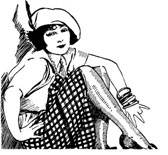
The Conversion of Ruth Snyder
A MYSTERY OF HISTORY
Ruth Snyder and her adulterous lover, Judd Gray, were convicted of murdering Ruth’s husband, Albert Snyder, while he was passed out, drunk on bootleg whiskey. Sentenced to death, they were executed minutes apart in the Sing Sing electric chair on January 12, 1928.
The pair and their crime garnered national attention, but it was Ruth’s story that captivated the public. New York’s Daily News reported, “The woman who commands, in one manner or another, the attention of the nation is Ruth Snyder, who stood by and urged her paramour, Judd Gray, to beat to death her art-editor husband with a sash-weight. The courts said she shall die for the brutal, premeditated and conceived-in-love-lust slaying” (Nov. 23, 1927).
There is more: Only weeks prior to the murder, Ruth had duped her husband into increasing his life insurance. For additional sensation, consider that her lover was a corset salesman who was also married.
The torrid affair and its aftermath have been the subject of stage productions and true-crime accounts, including historian Landis MacKellar’s The Double-Indemnity Murder: Ruth Snyder, Judd Gray, and New York’s Crime of the Century (2006), and served as the inspiration for Ron Hansen’s novel A Wild Surge of Guilty Passion (2011).
What stands out in the present is a question asked at the time, but one history has abandoned. Ruth Snyder, baptized a Lutheran, entered prison as a nonbeliever but died less than a year later as a Roman Catholic. Was her conversion sincere, or was it merely a ploy to obtain the sympathy of the only person with the power to stay her execution, New York Governor Al Smith, himself a Catholic?
You May Also Enjoy
Clayton requested a "formal tie to the monastery" while in jail. He said he was already leading a monastic life and was eager for it to be embraced by the Church.
When the Mass was translated into English, I noticed right away how often it says “Peace”: it’s repeated over and over again, like a heartbeat, clear through.
Before answering the question, “Why Rome?” I must respond to another: “Why not Takoma Park?” (Takoma Park, Maryland, is the world headquarters of Seventh-Day Adventism.)

